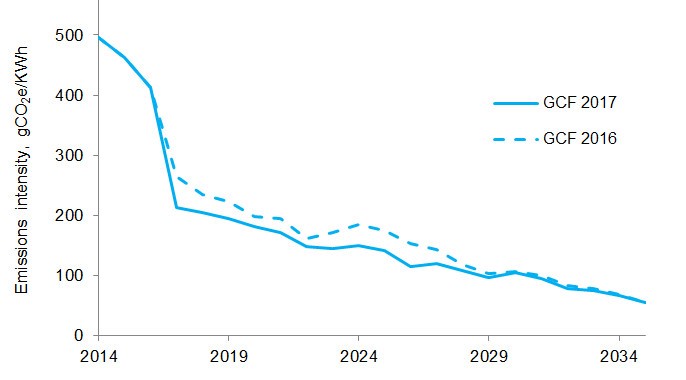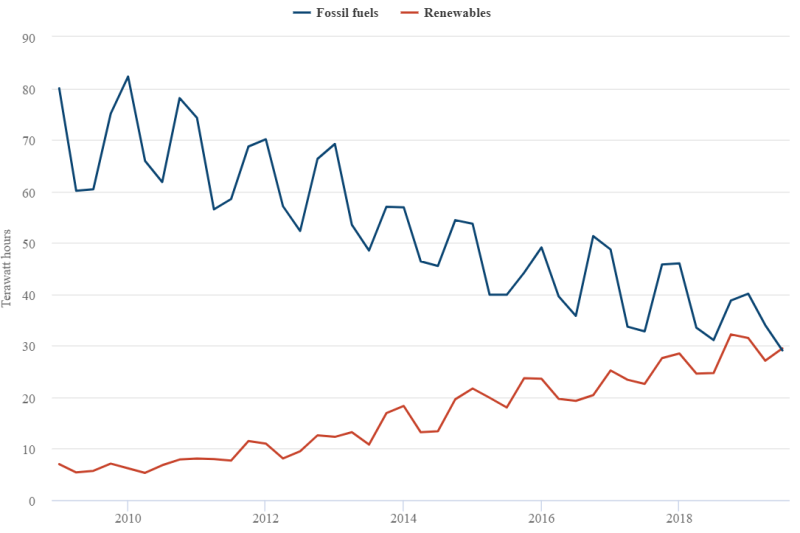5.1.4
Energy sourcing
Electricity stands out as the dominant energy source in retail buildings. As shown in Figure 5.1g, the BEES reports that of all the energy consumed in retail buildings, approximately 79% is from the use of electricity. Since the publication of the BEES report, the use of electricity within buildings has grown, as applications are more widespread and gas- or oil-fuelled appliances are becoming less common. It is likely that in the coming years the industry will shift even further towards the use of electricity.

Figure 5.1g: Retail energy consumption by fuel type, from BEES
For all electricity sourced directly from the UK National Grid, the emissions associated with use are determined by the fuel mix that is used to generate electricity. The UK electricity carbon factor is prone to fluctuate from year to year as the fuel mix consumed in UK power stations and the proportion of net imported electricity changes. The current UK electricity carbon factor as published by the Department for Environment, Food & Rural Affairs (DEFRA) is 0.233 kgCO2e per kWh of electricity consumed.[30]
The emissions intensity of the UK grid has decreased (compared with 2019) by 9%, due to a decrease in coal generation and an increase in renewable generation. This reduction trend in electricity grid carbon intensity will continue as the UK strives to decarbonise the grid by increasing the generation of electricity from renewable sources. Figures 5.1h and 5.1i show the historical trend and projections of UK carbon factors and the proportion of electricity generated from renewables and fossil fuels. The third quarter of 2019 was the first quarter to see renewable generation outstrip that of fossil fuels, and this should become more commonplace as increased investment in renewables continues.

Figure 5.1h: UK Grid Carbon factor trend and projections

Figure 5.1i: Quarterly electricity generation in the UK between 2009 and the third quarter of 2019[31]
The next largest energy requirement from retail sites comes from natural gas. Space heating, water heating and cooking are the primary users of natural gas in retail. In a similar manner to electricity, the emissions associated with the use of natural gas are determined by the mix of sources used to make up the UK grid supply of gas. The UK currently gets its gas from a wide range of sources to ensure consistent supply.
These include:
- North and Irish Sea production
- Pipelines from continental Europe and Norway
- Liquefied Natural Gas (LNG) shipped in from around the world
Gas from fields in the North and Irish Sea typically provide around 40% of gas supplies. However, production from these fields is now in decline as imports from abroad make up a greater part of supply. As a result, the carbon factor associated with natural gas is also prone to fluctuate from year to year as the gas blend varies, albeit with less magnitude than the factor for electricity. The current UK natural gas carbon factor as published by DEFRA is 0.18387 kgCO2e per kWh of natural gas consumed.[32]
With the natural gas carbon factor remaining fairly static and the electricity factor on a downward trend, it is no longer the case that the use of natural gas presents a better environmental option than utilising electricity from a rapidly transforming generation network.
[30] UK Government GHG Conversion Factors for Company Reporting (2020) - DEFRA
[31] Analysis: UK renewables generate more electricity than fossil fuels for first time (2019). Carbon Brief.
[32] UK Government GHG Conversion Factors for Company Reporting (2020) - DEFRA